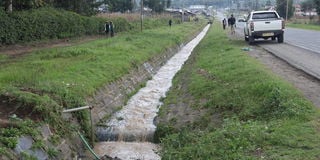KenHa's statement on Nyonjoro road woes leaves bad taste in residents' mouth

The drainage tunnel along Dundori road that redirects water towards Nyonjoro estate. Photo taken on October 26,2025.
Residents of Nyonjoro, Lanet are cautiously hopeful after the Kenya National Highways Authority (KeNHA) promised to address the flooding crisis that has plagued their community for over a decade.
But beneath the optimism lies a deep sense of frustration and a lingering question: Why did it take years of suffering for KeNHA to respond?
In a letter addressed to the Assistant Chief of Nyonjoro on October 28, the authority acknowledged receiving complaints about storm water from the Lanet–Ndundori (B20) road spilling into homes and farms.
In the letter, signed by Regional Director Eng. Fredrick Oyugah, KeNHA notes they carried out a joint inspection with local administrators and residents, concluding that the flooding results from runoff originating in the upper catchments of Ndundori and Wanyororo hills.
However, for many in Nyonjoro, this explanation raises more questions than it answers.
“If KeNHA was aware of the topography and natural drainage patterns before constructing or rehabilitating the Lanet–Ndundori road, why wasn’t a proper drainage system integrated into the design?" Questions Peter Kiragu, a resident and chairman in Nyonjoro estate.
He asks why residents should now bear the cost of technical oversight that could have been prevented with a thorough environmental assessment.
“This problem didn’t start yesterday. Every rainy season, we face the same nightmare, water from the road floods our homes and farms. It’s disheartening to see authorities respond only after years of complaints,” he states.
The authority’s admission that “land-use changes” and “increased surface runoff” have worsened the situation may be partly true, but it also points to poor coordination between state agencies tasked with planning and infrastructure development.
“It was observed that over the years, extensive land-use changes including conversion of agricultural farmlands into residential settlements, coupled with the continuous degradation of natural drainage channels and riparian areas, have significantly increased surface runoff volumes from the upper catchments, resulting in localized flooding within the Nyonjoro area, particularly around Mwereri Area and Kamfam,” reads part of the statement.
The Kenya Rural Roads Authority (KeRRA) is cited as a contributing factor since runoff from one of its roads (Wa Githioro along the Karunga -Kabatani- Githioro (C986) Road ) drains into KeNHA’s network, yet, residents are left wondering why these agencies only began talking to each other after years of destruction.
In its statement KeNHA states that it will now work with the Water Resources Authority (WRA) and the Nakuru County Government to map riparian zones and develop a storm water management plan that sounds like a long-overdue plan.
Why wasn’t this coordination done before construction or soon after the complaints were launched. Furthermore, the authority’s promise to “enforce riparian and environmental regulations” feels ironic, given that enforcement should have been part of the initial project planning.
Kiragu concludes saying “For us, true relief will only come when KeNHA moves from acknowledgment to concrete, transparent, and time-bound action. Until then, every downpour will serve as a reminder that poor planning and bureaucratic inaction have real human costs.”

